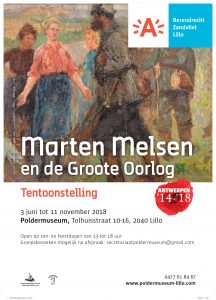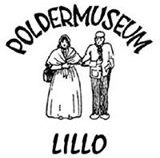The Koninklijke Heemkundige Kring van de Antwerpse Polder and the Stichting Marten Melsen VZW are organizing the exhibition “Marten Melsen and the Great War” from June 3rd till November 11th 2018 in the Poldermuseum Lillo. In this unique exhibition the public can discover the work of artist Marten Melsen during the period 1913-1919. There are also lettres and photos out of the collection of Marten Melsen exposed.
From the very beginning on, the war years brought immense destruction and human suffering. The fires moved relatively quickly from eastern and central Belgium to the fields in Western Flanders and northern France. In the occupied areas, Germans took over the political and economical administration, including in the capital of Brussels, birthplace of the artist-painter Martin Melsen, as well as in port city Antwerp and its northern suburbs at the Dutch borders, where the artist had moved to after his studies at the Brussels Academy. With his characteristic Brussels humour, he loved to paint the traditionalist peasants and farmers of the polder region, in a manner reminding us of his fellow-Fleming Breugel.
As of the end of 1914, this region saw masses of citizens scared of the Antwerp bombardments, fleeing to the neutral Netherlands, passing right in front of the artist’s house in Stabroek, less than a kilometer from the actual border. Not far from the artists’ studio, Germans rigorously check the country borders, inspiring the artist to paint their activities and portrays their pin-helmet-covered military staff. With his usual humor, he immortalizes these scenes of the enemy and war absurdities, in sharp contrast with the artwork by other Belgian or foreign artists during those long war years 1914-18.
The prewar years had seen the upcoming artist newly wed with a niece of his friend, the composer August de Boeck (1865-1937), and making him father of little Adriaan and Cecilia. The young family was not only confronted with Germans strategically positioned closeby, but even taking refuge in their own house The Fox field along the Hoogeind avenue. In certain situations, however, this forced friendship with the enemy turned into year-long friendships, even beyond the end of the war.
During the first, very hard, waryear 1915, life had seemed to come to a standstill: exhibitions, sales, supplies of art material, and of course food all became difficult to come by. Slowly but surely, the situation improved. By 1916 the artist can even boast a new solo-exhibition in Brussels, at the Cercle Artistique & Littéraire. Curiously, in this very particular socio-economic context, sales go well. And the year 1917 even surpasses the previous year , becoming the most succesful year in the entire life of the artist. That year, the artist will send artwork to very fine exhibitions, with great feedback and good sales. The press even presents Melsen as a revelation in modern Belgian art. The artist is now very inspired, dugs back into his habitual stables and creates lots of new artwork, both in the polder region as in the Pajottenland around Brussels, where his spouse Jeanne Goossens (1885-1959) originated from.
During these war years, the artist also experiments with etching, a difficult technique that allows to make artwork multiples with new effects, at lower cost. Moreover, in order to keep busy during those long winter months, Melsen will make proposals for illustrations for the literary works of his fellow-artist friends Georges Eekhoud and Felix Timmermans, as well as for the musical composer Jef Van Hoof.
In the year 1918, the war approaches its final days. These days, the artist immortalises regularly family scenes and his growing children. Once the war is officially declared finished, the large prestigious national and international exhibitions return: the artist will receive some fine honorary prizes
Even though the 1st World War times were an economical success for the artist Melsen, the war definitely had a lasting impact on him and his work. His painting style had evolved to luminism, but he admits that this new style is not really his : his favourite topics, the polder-based peasants, recently had evolved from centuries-old skills to modern managers of agrarian enterprises. The nineteenth century was definitely over. Even with his openness to new contemporary artistic trends in the years 1920-30, the artist Melsen, sensitive and with few words, will not adopt these trends, on the contrary : he will return to his original style from the end of the 19th century. Even though only slightly visible in the later works, we have the impression that the war, and its socio-economic impact, impacted the artist profoundly and irreversibly.

